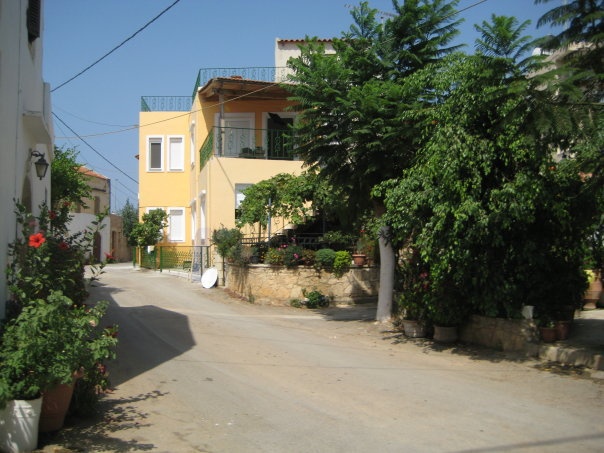
Uploaded on 2014-12-09 by stylianistarr
![ ***Part 1- Photo explanation*** This is a photo of my village 'Kampia' in Crete, Greece. In this photo electrical power lines between the houses, and an asphalt road are visible. In addition, to the left of the photo (not visible in photo) is an inactive water well system. About 40 years ago, in Kampia, there was no electricity, running water, or asphalt road. Also the closest pharmacy was 40 minutes by car. **Electricity** In Kampia, people would use oil lamps or beeswax candles for a light source before 1975. This meant, that people would sleep with the setting of the sun, and rise with the sun. Generations growing up in the 1970’s had more flexibility in when they slept and rose, since electricity was introduced and people could watch T.V., surf the Internet (1990’s), or study late into the night. In the 1980's there was a pay phone in the wealthiest woman’s’ house called Paizina. People from the village would go to her house if they wanted to call friends or relatives, and pay money according to location and time spent on the phone. By 1990, telephones became cheaper, and every household had one. **Health** Only 3 years ago, a pharmacy finally opened in a close by village, which is 20 minutes by car, the half of what it was 40 years ago. Now people can get their prescriptions, and other health related things more conveniently. **Transportation** In the 1970's there was a rocky trail, which only motorcycles could safely pass through since the roads that exist now were a part of the farmland in the 1970’s. In the 1980's a gravel road was constructed wide enough for farmers’ trucks to use safely. A few years after, an asphalt road was finally constructed and mobile car markets called "fournaris" [foor-nar-eace],"epiplopiis"[ep-ip-lo-pi-eace] (cars selling food, clothes, and house appliances) would come on a daily basis. These mobile car markets would go to various villages in the mountains, for it was convenient since villagers were busy doing various farming duties taking care of children, cleaning and cooking most of the day. Still to this day, despite most people having cars, the mobile car markets still come every day. Transportation infrastructure made these car markets available. **Water** In the 1960's there was a water reserve, which was a 30-minute walk from the village. People would load donkeys with large buckets to gather water for drinking, bathing, cooking, and cleaning. Luckily in 1970, a welling system was installed within the village, and the donkeys and people could rest! Though, hot water was another labor. Women would fill large wooden buckets and set them in the sun for a few hours until warm enough to bathe. **Final results** Finally in the late 1970’s, piping and electricity where installed. This meant hot water, air condition, light source, electric devices; such as washing machines and ovens instead of fire stoves! A new era was introduced in Kampia, and labor was greatly decreased. There is still yet to be a device to make food for us, though I do not think that food would be as great as my grandmother's who has been cooking for 60 years consecutively!! From these examples we can see that the impact and dependency on energy and other infrastructures is gargantuan. Less labor is needed when infrastructures are implemented, and more time can be spent with loved ones or for leisure in this case. Daily activities can be finished quickly and efficiently with the help of transportation infrastructure, health infrastructure, water infrastructure, and electricity infrastructure. ***Part 2- Connection to statement*** The way that this photo from Kampia relates to the statement “With the beginning of the 21st century, buildings and cities are becoming interactive physical systems and information software systems not just collections of material. Water, energy, transportation and health infrastructure are thus crucial elements in designing future sustainable urban systems and human habitats." is because it states; that water, energy, transportation, and health infrastructure are crucial elements in designing future sustainable urban systems and human habitats. This is the same conclusion I came to earlier with my examples of different infrastructures, which are now operating in Kampia. In Kampia, as I stated earlier, the road was built between the farmland, and houses where built without plan. Houses in villages were merely built to live in without having deep consideration about the future, since the land was primarily used for farming, and they didn’t have to take into consideration the long-term effects, and did not have the means to implement different infrastructures. But with modernism growing, and new technological methods, farmers now take into consideration the long-term effects of different infrastructures. The 21st century has changed our way of life significantly. Buildings are being built as physical and software systems, not just as ordinary collections of materials. This is a significant change, because we are now starting to take into consideration the long-term effects. There are many elements in designing a future city, for example, the feedback loop is also a helpful tool. It helps to analyze what is going wrong and right in the planning of a city, and how to fix future problems in planning, and implementing. ][2] [1]: https://edxuploads.s3.amazonaws.com/14181345709842198.jpg [2]: https://edxuploads.s3.amazonaws.com/14181343411949617.jpg Fun Fact: A passive cooling technique in Greek homes has been newly introduced. "Coolwall" paint is used on numerous houses which cools the houses during the summer. When Coolwall paint is applied, it has the same affect that white houses do, it reflective in the IR which reduces heat.